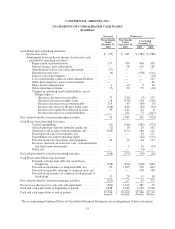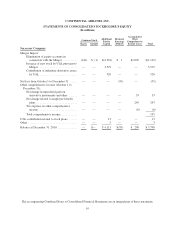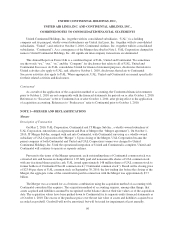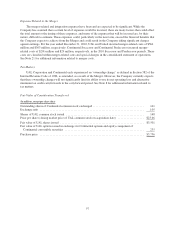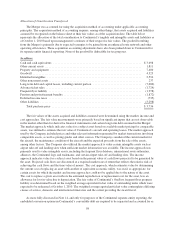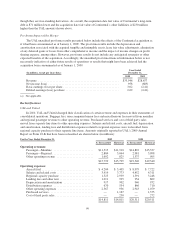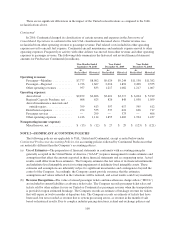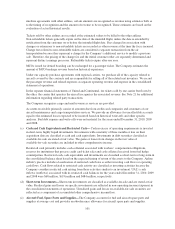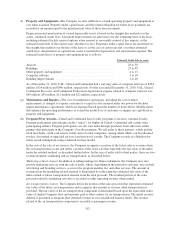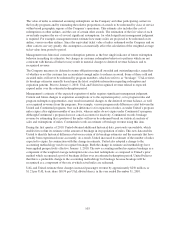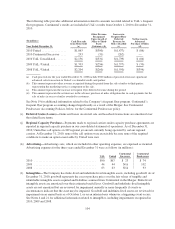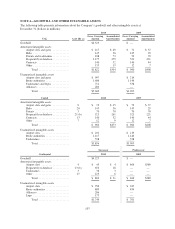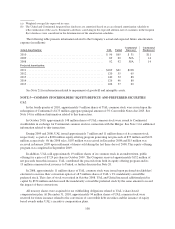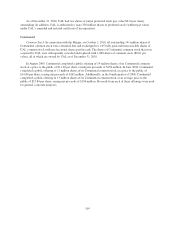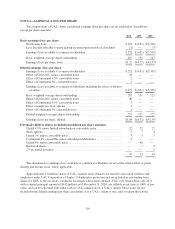United Airlines 2010 Annual Report Download - page 103
Download and view the complete annual report
Please find page 103 of the 2010 United Airlines annual report below. You can navigate through the pages in the report by either clicking on the pages listed below, or by using the keyword search tool below to find specific information within the annual report.interline agreements with other airlines, certain amounts are recognized as revenue using estimates both as
to the timing of recognition and the amount of revenue to be recognized. These estimates are based on the
evaluation of actual historical results.
Tickets sold by other airlines are recorded at the estimated values to be billed to the other airlines.
Non-refundable tickets generally expire on the date of the intended flight, unless the date is extended by
notification from the customer on or before the intended flight date. Fees charged in association with
changes or extensions to non-refundable tickets are recorded as other revenue at the time the fee is incurred.
Change fees related to non-refundable tickets are considered a separate transaction from the air
transportation because they represent a charge for the Company’s additional service to modify a previous
sale. Therefore, the pricing of the change fee and the initial customer order are separately determined and
represent distinct earnings processes. Refundable tickets expire after one year.
MCOs issued for denied boarding can be exchanged for a passenger ticket. The Company estimates the
amount of MCO breakage revenue based on historical experience.
Under our capacity purchase agreements with regional carriers, we purchase all of the capacity related to
aircraft covered by the contracts and are responsible for selling all of the related seat inventory. We record
the passenger revenue and related expenses as separate operating revenue and expense in the consolidated
statement of operations.
In the separate financial statements of United and Continental, for tickets sold by one carrier but flown by
the other, the carrier that operates the aircraft recognizes the associated revenue. See Note 21 for additional
information regarding related party transactions.
The Company recognizes cargo and mail revenue as services are provided.
Accounts receivable primarily consist of amounts due from credit card companies and customers of our
aircraft maintenance and cargo transportation services. We provide an allowance for uncollectible accounts
equal to the estimated losses expected to be incurred based on historical write-offs and other specific
analyses. Bad debt expense and write-offs were not material for the years ended December 31, 2010, 2009
and 2008.
(c) Cash and Cash Equivalents and Restricted Cash— Cash in excess of operating requirements is invested
in short-term, highly liquid investments. Investments with a maturity of three months or less on their
acquisition date are classified as cash and cash equivalents. Investments in debt securities classified as
available-for-sale are stated at fair value. The gains or losses from changes in the fair value of
available-for-sale securities are included in other comprehensive income.
Restricted cash primarily includes cash collateral associated with workers’ compensation obligations,
reserves for institutions that process credit card ticket sales and cash collateral received from fuel hedge
counterparties. Restricted cash, cash equivalents and investments are classified as short-term or long-term in
the consolidated balance sheet based on the expected timing of return of the assets to the Company. Airline
industry practice includes classification of restricted cash flows as either investing cash flows or operating
cash flows. Cash flows related to restricted cash activity are classified as investing activities because the
Company considers restricted cash arising from these activities similar to an investment. UAL’s cash
inflows (outflows) associated with its restricted cash balances for the years ended December 31, 2010, 2009
and 2008 were $68 million, $(19) million and $484 million, respectively.
(d) Short-term Investments—Short-term investments are classified as available-for-sale and are stated at fair
value. Realized gains and losses on specific investments are reflected in non-operating income (expense) in
the consolidated statements of operations. Unrealized gains and losses on available-for-sale securities are
reflected as a component of accumulated other comprehensive income/loss.
(e) Aircraft Fuel, Spare Parts and Supplies—The Company accounts for fuel and aircraft spare parts and
supplies at average cost and provides an obsolescence allowance for aircraft spare parts and supplies.
101




